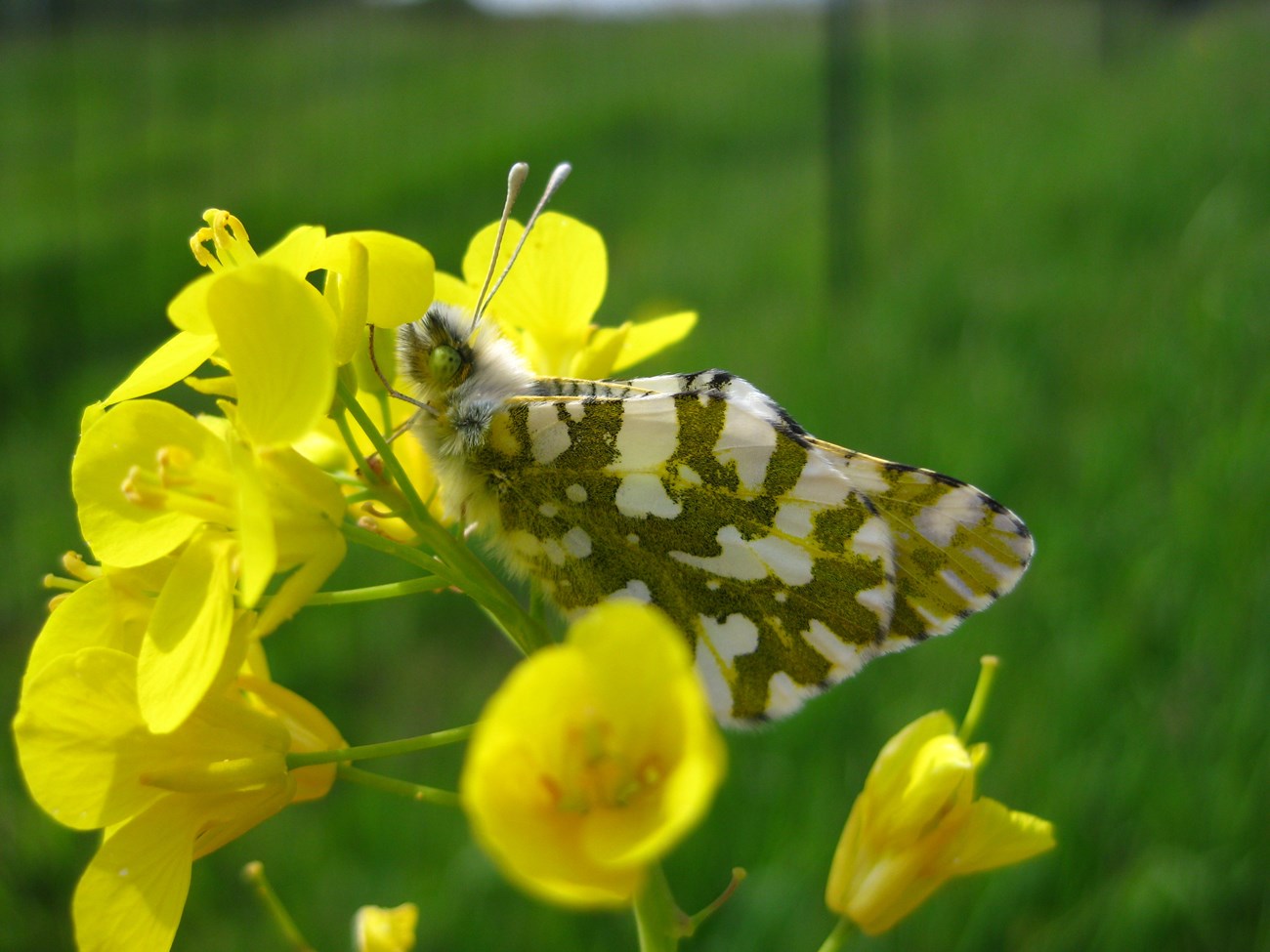|
Imagine you could turn on the television and watch your favorite animal’s life as a sitcom. What creature’s wild life would you choose? For San Juan Island National Historic Park (NHP) biologist, Jenny Shrum, no creature’s life is more tantalizing than that of the island marble butterfly. “If [the island marble butterfly] were going to have a sitcom, it would be so juicy - with their mysterious past, naughty reliance on non-native plants, and promiscuous behavior,” said Shrum. But the plot twist? These streaky, white-winged pollinators are rapidly diminishing on San Juan Island. Thanks to Shrum and others at the park, however, this sitcom may not be so predictable. 
Jenny Shrum/NPS Fluttering with ExtinctionJust a month ago (April 2018), the island marble butterfly – or simply called a ‘marble’ - was proposed the United States Fish and Wildlife Service (USFWS) for listing under the Endangered Species Act (ESA). “Currently it is only found on San Juan Island, and almost exclusively within the Park, save one slope just outside the park boundary,” said Shrum. The marble’s numbers have fluctuated – they were even thought to be extinct for 90 years. Despite their rediscovery on San Juan Island in 1998, their populations continue to face a variety of threats. “There are several criteria used to determine whether a species warrants listing. The island marble met many…” said Shrum. “Essentially reduced range, dwindling numbers, loss of habitat, and persisting threats were described by USFWS as the primary reasons it was proposed for listing.” Some of these “persisting threats” include development and agriculture, as well as deer grazing on plants that marbles use for laying eggs, according to Shrum. However, the park isn’t wasting any time while it awaits the decision of the USFWS. On island time with the Island MarbleShrum arrived at San Juan Island NHP in 2014, with an understanding she would be working with youth groups. But as she entered her second day at the park, she was told she would be stepping out of the field and into the lab, much to her dismay. “I thought, I don’t want to do this, I don’t want to be stuck in a lab with a silly butterfly”. Shrum was being asked to oversee the parks small-scale butterfly rearing program, which began 2013. Like similar captive rearing efforts, the program creates a controlled environment for the marble caterpillars to grow free from typical threats, safe from those predators and weather. “In the lab, the caterpillars grow on their specific host plant,” said Shrum. “The host plants are non-native mustard plants. We don’t know what the natural plant would have been before these specific mustard plants grew on the island.” Lucky for Shrum – and for the “silly” butterflies - her feelings on her reassignment quickly changed. For Shrum, it offered a unique experience. “It became an excuse to slow down,” she said. “In the National Park Service, we usually try to stay far away because we don’t want to impact anything in the park. But this was something very hands-on…I get to know the relationship between the caterpillar and the host plant on an intimate level.” And for the marble, this hands-on effort offered a fighting chance. 
Karen Reagan/USFWS Tune in for the season finaleAs the program enters its fifth official year, now with Shrum as the official lead for the “on-the-ground conservation efforts to protect the island marble butterfly”, the park has begun to utilize the rearing program as a way to conduct research. “I’m excited to see what we learn from the DNA analysis,” said Shrum. Yes, DNA analysis on a butterfly. It’s not as simple as sticking a tiny needle in one of the little creature’s appendages, but it is easier than it may seem: it involves collecting old chrysalises and insect larvae excrement, called frass. The results of these analyses could unlock many of the marble’s secrets and answer many remaining questions for the park. “How distinct are the populations collected from the various host plants? Are they loyal to particular host plants? How much diversity exists across the entire population? Is there greater diversity between individuals now versus the individuals in the collections in Canada?” Shrum wonders. Just as the island marble butterfly floats aloft above the park’s coastal prairie, these questions, as well as its future protections under the ESA, do too. In the meantime, the park and its partners are thankful for the captive rearing program’s success. “When [Shrum] showed me the first butterfly that had come out of its cocoon this season, I was filled with joy,” said Sara Dolan. Integrated Resource Manager, Sara Dolan, has only been with San Juan NHP a month but has quickly understood the importance of the program. “It’s great to see something good that is working,” she said. When Shrum tries to picture the park without the marble filling its role, it is not the butterfly itself, but what she believes it is symbolic of, that is special. “Butterflies definitely act as pollinators, and prey species, but talking about roles is a funny conversation for almost any species. Its role is to survive…Myself and everyone on the team see this little butterfly in the prairie fluttering madly around the prairie, striving to survive, and decide – we need to the protect this guy.” Rest assured, the series finale of this sitcom isn’t going to be one you want to miss. |
Last updated: June 18, 2018
